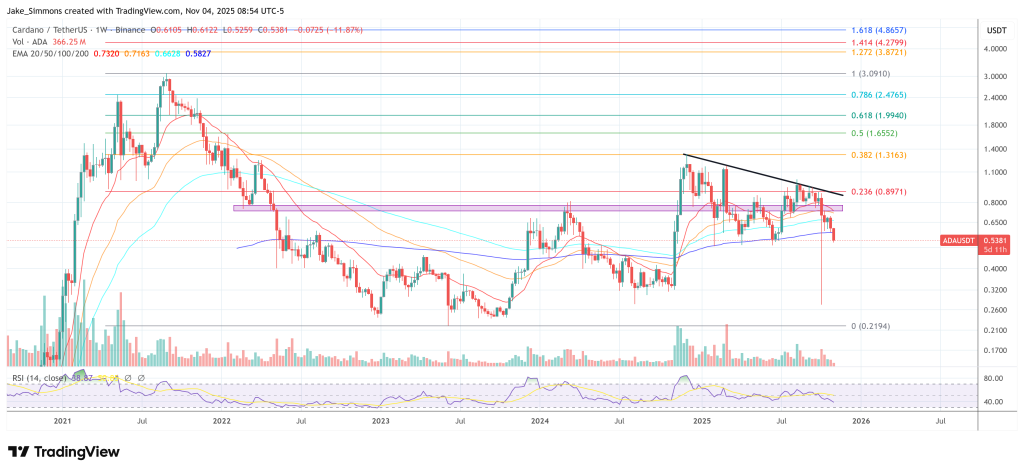On the crisp autumn day of November 3rd, Charles Hoskinson, the maestro of Cardano, found himself ensnared in the tangled web of crypto journalism-a realm where truth is often as fleeting as a butterfly in a hurricane 🦋. In a video likely filmed in a room adorned with the trappings of intellectual pursuits, Hoskinson delivered a rebuttal with the precision of a chess grandmaster, dismissing sensational headlines that falsely accused him of blaming Cardano’s users for the network’s DeFi deficiencies. “I never once blamed anyone from the Cardano ecosystem for the DeFi [woes],” he declared, his tone oscillating between exasperation and a kind of weary amusement.
“I’m sorry, crypto media,” he lamented, “that you guys are […] and you just want clickbait headlines. You guys have to cut this the […] out.” His words, punctuated by the kind of sardonic humor Nabokov himself might appreciate, flew like arrows aimed at the heart of journalistic sensationalism. “Not a single person in the Cardano ecosystem who I am blaming for our DeFi situation right now,” he reiterated, as if addressing a room full of particularly dense students.
The Misunderstood Mismatch: A Tale of Staking and DeFi
Hoskinson’s argument was as much a numerical observation as it was a philosophical musing. He pointed to the undeniable divergence between Cardano’s robust participation in staking and governance and its more modest engagement in DeFi protocols-a disparity that, if corrected, could elevate Cardano’s Total Value Locked (TVL) to dizzying heights. “If there was proportionality there… our TVL would be at least five to 10 billion,” he posited, his voice tinged with the faintest hint of what might have been regret or perhaps simply the weight of unfulfilled potential.
He cited user count comparisons with the precision of an entomologist cataloging rare species. “Some third-party measurements are asserting that Cardano has only 10,000 to 50,000 actual users when there’s 1.3 million who are using staking,” he explained, his tone betraying a mixture of incredulity and frustration. For Hoskinson, this delta was not a condemnation but a clarion call for introspection and collective action within the ecosystem.
“I’m not blaming them for not participating,” he clarified, as if addressing an invisible chorus of critics. “Never once said it’s their fault and they’re bad people and they’ve done something wrong.” Instead, he called for a candid community dialogue to uncover the myriad reasons-slippage, fees, user experience, yields, safety concerns, education-behind users’ choices. “There could be 150,000 different reasons for that,” he mused, his voice a blend of pragmatism and mild exasperation.
The solution, in his view, lay not in sensational headlines but in coordinated governance. He urged Cardano stakeholders to treat the participation gap as a 2026 workstream, advocating for targeted initiatives funded through delegated authority. “We as an ecosystem have to ask why that mismatch exists and how can we correct that mismatch,” he said, his tone shifting from exasperation to something resembling cautious optimism.
The dispute, he explained, originated when media outlets transmuted a data-driven observation into a blame narrative. “People say something very specific, very targeted, and then it gets misinterpreted, and then everybody judges you based upon the headlines,” he lamented, his voice tinged with the kind of resigned cynicism Nabokov might reserve for a particularly ill-conceived novel.
Hoskinson’s critique of crypto media practices was as scathing as it was unapologetic. “If you continue to broadcast, you’re lying to people,” he accused, adding, “I expect that from the crypto media because they are scum. They do lie. Everything’s sensational. Everything’s clickbait.” His words, delivered with a mix of theatrical disdain and biting humor, framed the entire episode as a corrective to prevent a headline cycle from ossifying into accepted fact.
Beneath the media criticism, the practical essence of his message remained steadfast: mobilizing existing users rather than conjuring new ones. “We have the users. We have the capital,” he asserted, his tone shifting from exasperation to pragmatic resolve. “For some reason, those users with their capital are not participating in DeFi.” While he acknowledged having personal “suspicions” and hearing “frustrations” from ecosystem participants, he stopped short of diagnosing root causes, instead calling for an open, data-first process to “systematically chip away” at barriers that deter stakers and governance participants from crossing into DeFi activity.
Hoskinson’s refrain, delivered with the consistency of a metronome, was clear: “There is a mismatch between the people participating in staking and governance-of which it’s seven figures over a million people-and the people participating in DeFi.” His words, a blend of exposition and mild exasperation, underscored his commitment to addressing the issue without casting blame.
At the time of this narrative’s composition, ADA traded at $0.538, a figure as unremarkable as it was arbitrary in the grand tapestry of Hoskinson’s broader discourse.

Read More
- AAVE PREDICTION. AAVE cryptocurrency
- SKY PREDICTION. SKY cryptocurrency
- CNY JPY PREDICTION
- ETC PREDICTION. ETC cryptocurrency
- USD CAD PREDICTION
- EUR GBP PREDICTION
- QNT PREDICTION. QNT cryptocurrency
- GBP CHF PREDICTION
- BNSOL PREDICTION. BNSOL cryptocurrency
- ETH PREDICTION. ETH cryptocurrency
2025-11-05 09:14